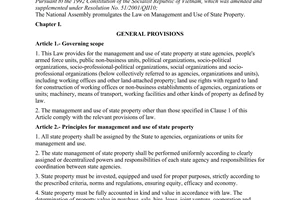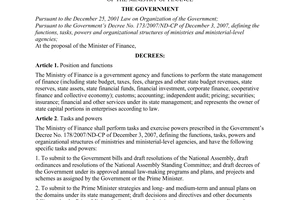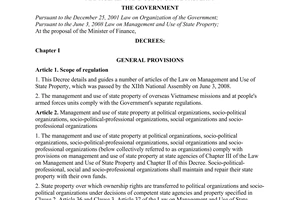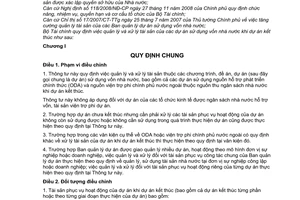Nội dung toàn văn Circular No. 87/2010/TT-BTC on management and handling of assets of state-funded
|
THE FINANCE MINISTRY |
SOCIALIST
REPUBLIC OF VIET NAM |
|
No. 87/2010/TT-BTC |
Hanoi, June 15, 2010 |
CIRCULAR
ON MANAGEMENT AND HANDLING OF ASSETS OF STATE-FUNDED PROJECTS UPON THEIR COMPLETION
Pursuant to the December 16, 2002 Law on the State Budget;
Pursuant to the June 9, 2008 Law on Management and Use of State Property;
Pursuant to the Government's Decree No. 52/ 2009/ND-CP of June 3, 2009,
detailing and guiding a number of articles of the Law on Management and Use of
State Property;
Pursuant to the Government's Decree No. 137/2006/ND-CP of November 14, 2006, on
decentralization of the state management of state property at administrative
agencies and public non -business units and property over which state ownership
is established:
Pursuant to the Government's Decree No. 118/2008/ND-CPof November 27, 2008,
defining the functions, tasks, powers and organizational structure of the
Ministry of Finance;
Pursuant to the Prime Minister's Directive No. 17/2007/CT-TTg of July 25. 2007.
on enhanced management of assets of state-funded project management units;
The Finance Ministry provides the management and handling of assets of
state-funded projects upon their completion as follows:
Chapter I
GENERAL PROVISIONS
Article 1. Scope of regulation
1. This Circular provides the management and handling of assets of state-funded programs schemes and projects (below collectively referred to as projects), including also projects funded by official development assistance (ODA) and foreign non-governmental aid belonging to state budget revenues, upon project completion.
This Circular does not apply to projects of economic organizations that receive funding and non-project asset supports from the state budget.
2. Assets of an uncompleted project which are neither usable nor necessary for project implementation shall be handled under this Circular.
3. When a specific document on ODA or foreign non-governmental aid provides otherwise, the handling of assets of a project upon its completion complies with that document.
4. For a project management unit assigned to manage different projects which operates as a non-business unit or an enterprise, assets for its general operation shall be managed and handled under regulations on management and use of state property at public non-business units or enterprises while those for the operation of each project shall be managed and handled under this Circular.
Article 2. Subjects of application
1. Assets for the operation of a project upon its completion (including partial or phase-based completion of projects) include:
a/ Office buildings and other land-attached assets, including also the land area allocated for project construction;
b/ Means of transport;
c/ Machinery, working facilities and equipment, and other assets for project operation.
2. Assets used in activities of foreign experts and consultants, supervisors and builders that implement projects funded with ODA or foreign non-governmental aid which are transferred by those experts or contractors to the Vietnamese party upon project completion (below collectively referred to as foreign-transferred assets).
3. Supplies recovered from the dismantlement of old infrastructure works for public or national interest (below referred to as infrastructure works) upon construction of new ones.
Chapter II
HANDLING OF ASSETS FOR PROJECT OPERATION
Article 3. Asset preservation
1. Upon completion of a project, its investor owner or project management unit (below collectively referred to as project management unit) shall properly preserve assets and their dossiers until they are handed over to an eligible agency, organization, unit or project or until they are sold or liquidated under a decision of a competent authority.
When a project is completed and its project management unit is dissolved but its assets have not been completely handled, the project managing agency shall preserve the assets and their dossiers and perform other tasks of the project management unit under this Circular.
2. The dismantlement, change of the structure, components or spare parts of assets; lease, lending or use of such assets without permission from competent state agencies arc prohibited.
Article 4. Asset handling modes
Assets for the operation of a project upon its completion shall be handled as follows:
1. Transfer of assets to state agencies, public non-business units, people's armed forces units, political organizations or socio-political organizations (below collectively referred to as agencies, organizations and units) that wish to use them and lack assets compared to asset use quotas and norms set by competent state agencies; transfer to other projects for their operation.
2. Liquidation of assets which have expired and are no longer usable; unusably or irreparably broken assets; and office buildings or other land-attached assets to be dismantled under a decision of a competent state agency, and other assets permitted for liquidation under law.
3. Sale of assets which are neither transferred nor liquidated under Clauses 1 and 2 of this Article. Assets shall be sold by public auction under law except the following cases, which are permitted for sale to designated buyers:
a/ Organizations or individuals register to buy assets on land or to receive transferred land use rights for the socialization of educational, vocational, healthcare, cultural, physical training and sports and environmental activities in conformity with approved planning. When two or more organizations or individuals register to buy assets on land or to receive transferred land use rights for this purpose, assets shall be put up for auction;
b/ Past the time limit for registration to participate in an asset auction, only one organization or individual registers to buy assets and offers a price at least equal to the reserve price;
c/ Assets are revaluated at under VND 50 million/unit.
4. For the land area allocated (or temporarily allocated) for project construction, after the project is completed, the project management unit shall return it to the provincial-level People's Committee for handling under the land law.
Article 5. Competence to handle assets of centrally run projects
1. The Minister of Finance may decide: a/ To sell office buildings and other land-attached assets at the request of ministers and heads of ministerial-level agencies, government-attached agencies or central agencies (below referred to as ministers and heads of central agencies):
b/ To transfer assets between ministries and central agencies or centrally run agencies, organizations, units and projects and locally run agencies, organizations, units and projects at the request of ministers and heads of central agencies and chairpersons of concerned provincial-level People's Committees.
2. Ministers and heads of central agencies may decide:
a/ To transfer assets between agencies, organizations and units under their management;
b/ To transfer assets to other projects under their management;
c/ To sell assets other than those specified at Point a. Clause 1 of this Article:
d/ To liquidate assets.
The transfer of office buildings and other land-attached assets and the transfer, sale and liquidation of cars of all types stipulated in this Clause may be conducted after obtaining written agreement of the Ministry of Finance.
Article 6. Competence to handle assets of locally run projects
1. The Minister of Finance may decide to transfer assets of locally run projects to centrally run agencies, organizations, units and projects or to other provinces and centrally run cities at the request of ministers, heads of central agencies and chairpersons of concerned provincial-level People’s Committees.
2. Chairpersons of provincial-level People's Committees may decide to transfer assets within their provinces or centrally run cities; sell or liquidate office buildings, other land-attached assets and means of transport at the request of directors of provincial-level Finance Departments and heads of concerned agencies; and decentralize the transfer, sale or liquidation of remaining assets.
Article 7. Asset handling order
1. Within 15 days after the completion of a project, the project management unit shall make an inventory record of assets for the project operation (according to Form No. 01/TSDA attached to this Circular, not printed herein) and submit it to the project managing ministry or central agency (for centrally run projects); or the provincial-level department, division or sector, or district-level People's Committee managing the project (for locally run projects).
When assets are found redundant or deficient through inventory, such shall be stated in the asset inventory record, together with explicit reasons and responsibilities therefor and proposed handling measures under regulations on fixed-asset management and use of the agency, organization or unit.
2. Ministries and central agencies (for centrally run projects) and provincial-level departments, divisions and sectors and district-level People's Committees (for locally run projects) shall compile dossiers of request to handle assets of completed projects for handling according to their competence or submission to competent authorities for handling under Articles 5 and 6 of this Circular.
A dossier of request for asset handling comprises:
a/ A written request for asset handling;
b/ A list of assets requested for handling, made according to Form No. 02/TSDA attached to this Circular (not printed herein):
c/ For assets to be transferred to agencies, organizations, units or projects, written requests for receipt of assets from concerned agencies specified at Point b. Clause 1, Article 5. and Clauses 1 and 2. Article 6 of this Circular.
3. When a project management unit or project managing agency fails to propose an asset handling plan or proposes a plan incompliant with this Circular, the state agency competent to approve asset handling plans specified in Articles 5 and 6 of this Circular shall recover the assets for handling under the law on state property management and use.
4. After a decision on asset handling is issued by a competent state agency, assets shall be handled as follows:
a/ For assets to be transferred: The project management unfit shall assume the prime responsibility for, and coordinate with the asset-receiving agency, organization, unit or project in. handing over the assets under the Finance Ministry's circular guiding the receipt and handover of assets between administrative and non-business agencies and economic organizations under decisions of competent agencies.
b/ For assets to be sold: The order and procedures for auction or sale to designated buyers comply with the Government's decree and the Finance Ministry's circular detailing and guiding the Law on Management and Use of State Property.
c/ For assets to be liquidated: The liquidation mode, order and procedures comply with the Government’s decree and the Finance Ministry's circular detailing and guiding the Law on Management and Use of State Property.
d/ For infrastructure construction investment projects implemented at different levels and assets for the operation of centrally run projects equipped in different provinces and centrally run cities, the central project management unit may authorize local agencies, organizations or units directly using those assets to sell or liquidate assets under decisions of competent state agencies defined in Article 5 of this Circular.
e/ When selling or liquidating assets for project operation, the asset-handling unit shall issue the Finance Ministry's invoice on sale of state property to the buyers.
Chapter III
HANDLING OF ASSETS TRANSFERRED BY FOREIGN PARTIES TO THE VIETNAMESE GOVERNMENT
Article 8. Asset receipt and preservation
1. A project owner shall receive foreign-transferred assets. An asset receipt record shall be made according to Form No. 03/TSDA attached to this Circular (not printed herein), specifying the quantity and status of assets, their value (if any), enclosed with asset-related dossiers.
2. A project owner shall properly preserve received assets and their dossiers until they are transferred to another agency, organization, unit or project or sold or liquidated under a decision of a competent authority.
Dismantlement, change of structure, components or spare parts of assets; or lease, lending or use of assets without a competent state agency's decision are strictly prohibited.
3. For foreign-transferred assets for which tax obligations have not been fulfilled, the project owner shall carry out transfer procedures and pay taxes under law before proposing a competent authority to determine the State's rights to own assets and approve the asset handling plan.
When the project owner fails to advance funds for tax payment, it shall report such to the state agency competent to approve the asset handling plan for decision on tax payment after asset sale or liquidation or transfer to the asset-receiving agency, organization, unit or project for carrying out tax payment procedures under law.
Article 9. Establishment of state ownership of transferred assets
1. A project owner shall propose a competent agency specified in Clause 2 of this Article to decide to establish state ownership of received assets under law.
2. Competence to decide state ownership:
a/ The Minister of Finance may decide to establish state ownership of assets transferred by experts and contractors implementing centrally run projects;
b/ Chairpersons of provincial-level People's Committees may decide to establish state ownership of assets transferred by experts and contractors implementing locally run projects.
Article 10. Modes, competence and order of asset handling
1. Modes, competence and order of asset handling comply with Articles 4, 5. 6 and 7 of this Circular.
2. When selling or liquidating assets transferred by a foreign party to the Vietnamese Government, the asset-handling unit shall issue the Finance Ministry's invoices on sale of assets confiscated into the state fund to the buyers.
Chapter IV
HANDLING OF SUPPLIES RECOVERED FROM THE DISMANTLEMENT OF OLD INFRASTRUCTURE WORKS
Article 11. Dismantlement and preservation of recovered supplies
1. When building an infrastructure work, a project management unit shall dismantle or hire a licensed organization or individual (if any) to dismantle old infrastructure works and recover usable supplies for handling under regulations (except for an investment project in which the builder is responsible for such dismantlement as provided by the project approving authority).
2. The project management unit shall properly preserve supplies recovered from the dismantlement of old infrastructure works until they are transferred or sold under the decision of a competent authority.
Lease, lending, use or sale without permission of supplies recovered from the dismantlement of old infrastructure works is strictly prohibited.
Article 12. Handling modes
1. Supplies recovered from the dismantlement of old infrastructure works shall be transferred or sold under Article 4 of this Circular.
2. For an investment project in which the value of recovered supplies is included in the project's total investment as provided by the project approving authority, the project contractor shall handle assets under law, not under this Circular.
Article 13. Handling competence and order
1. The competence and order to handle supplies recovered from the dismantlement of old infrastructure works comply with Articles 5, 6 and 7 of this Circular.
2. When selling supplies recovered from the dismantlement of old infrastructure works, the asset handling unit shall issue the Finance Ministry's invoices on sale of state property to the buyers.
Chapter V
FINANCIAL MANAGEMENT IN ASSET HANDLING
Article 14. Expenses arising in asset handling
1. Asset preservation expenses: Rents of warehouses and storage yards for asset preservation, asset protection expenses.
2. Expenses for transfer procedures and tax payment (if any) for assets transferred by foreign parties to the Vietnamese Government.
3. Expenses for the dismantlement and recovery of supplies of old infrastructure works upon construction of new ones (when these expenses are not included in the total investment of the project to build new infrastructure works).
4. Expenses for asset auction: Expenses for determination of the reserve price; expenses for auction in case of authorized auction by licensed auction institutions.
When an auction is conducted by a valuation and auction council, expenses for asset auction include expenses for determination of the reserve price, public notification and posting up of the auction, organization of the auction, and allowances for council members and other auction-related expenses.
5. Asset liquidation expenses: Expenses for the sale or dismantlement or disposal of assets.
6. Expenses arising in asset handover and takeover.
7. Other related expenses.
Article 15. Spending levels
The spending level for each expense defined in Article 14 of this Circular complies with criteria, norms and regimes provided by competent state agencies. When such criteria, norms or regimes are unavailable, heads of asset-handling agencies may decide on spending levels in accordance with the State's current financial management regime and shall take responsibility for their decisions.
Article 16. Funding sources
1. For assets to be sold or liquidated under decisions, expenses specified in Article 14 of this Circular shall be covered by proceeds from asset auction or liquidation. When no proceeds are gained from the asset handling or such proceeds are insufficient to cover expenses, the deficit shall be accounted into other expenses of the project.
2. For assets to be transferred, the asset-receiving agency, organization or unit shall pay related expenses.
Article 17. Management and use of proceeds from asset sale and liquidation
Proceeds from the sale or liquidation of assets after related expenses under Article 14 of this Circular are deducted shall be paid to (he state budget under the state budget law.
Chapter VI
IMPLEMENTATION PROVISIONS
Article 18. Organization of implementation
1. Ministries, central agencies and provincial-level People's Committees shall:
a/ Direct the management and handling of assets of projects under their management according to this Circular and relevant laws;
b/ Make annual reports on the handling of assets of completed project according to Forms No. 04/TSDA and No. 05fTSDA attached to this Circular (nut printed herein) and send them to the Ministry of Finance before January 31 of the subsequent year.
2. The Public Asset Management Department and provincial-level Finance Departments shall assist the Minister of Finance and chairpersons of provincial-level People's Committees in guiding and examining the management and handling of assets of completed projects under this Circular.
Article 19. Effect
1. This Circular takes effect on August 1, 2010.
2. To annul the Finance Ministry's Circular No. 116/2O05/TT-BTC of December 19, 2005, guiding the management and handling of assets of state-funded projects upon their completion.
3. Assets of projects completed before the effective date of this Circular for which no handling decision has been issued shall be handled under this Circular. Those with handling decisions shall be handled under regulations at the time when handling decisions were issued.
4. Any problems arising in the course of implementation should be reported to the Ministry of Finance (the Public Asset Management Department) for coordinated settlement.-
|
|
FOR THE MINISTER OF FINANCE |




